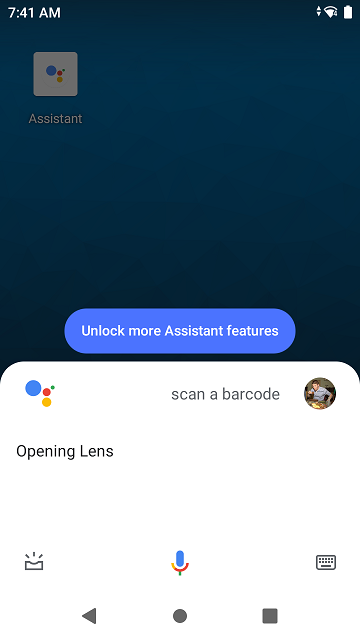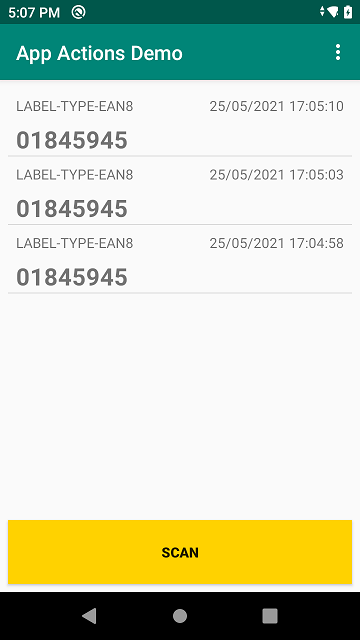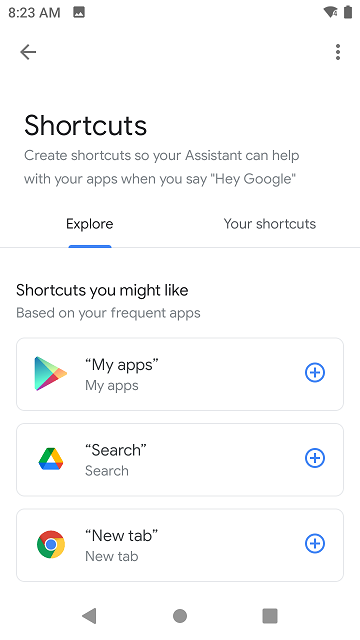Please be aware that this application / sample is provided as-is for demonstration purposes without any guarantee of support
Demo to show how to use App Actions (Shortcuts) on Zebra Mobile Computers
Google IO 2021 announced the beta release of the App Actions using the Android Shortcuts framework. This is an enhancement to the existing Google Assistant integration that used actions.xml. The announcement centred around using Built-in Intents, first introduced in 2020 and the new Custom Intents. Be aware however that the official "fitness tracker" sample app for app actions has not received an update in nearly a year.
I noticed that one of the built-in Intents was "Get Barcode" so I thought it made sense to experiment with App Actions on a Zebra device, especially since the IO announcement included one of our major retail customers.
I have previously written about:
- How you can add voice recognition to your app using Google DialogFlow
- Using DataWedge to respond to voice commands offline and
- Upgrading to V2 of the DialogFlow engine.
App Actions appear to achieve the same use cases (responding to user requests) without integrating with a backend server.
A new Code Lab for App Actions with Shortcuts was released alongside Google IO 2021 so I followed that. There is also a webinar. This code lab covers the basic setup & prerequisites such as uploading your app to an Internal Play Store test track, signing in with the same Google account everywhere and configuring the (very Alpha) Assistant test tool for Android Studio
I previously wrote an application to demonstrate barcode capture on Zebra Android devices using Kotlin, which I used as a base app to add App Actions to.
I am testing with a Zebra TC52 running Android 10, though any Zebra Android device running Lollipop (for App Actions) and DataWedge 6.4 or higher should work. I also installed the separate Assistant app from the Play Store to provide a better user experience but this was not necessary.
Did you know, if you ask Google assistant to "Scan a Barcode" it will bring up Google Lens?
There is obviously a better way to scan barcodes on Zebra devices and you can add additional capabilities to the Assistant by implementing one of the built-in Intents; built-in Intents use pre-defined machine learning models on the device to recognise a user's intention, for example Get Barcode will be recognised when the user says something like:
- Scan to pay on Example App
- Example App scan barcode
In order to implement Get Barcode into my existing app, I needed to make the following changes:
Create a shortcuts.xml file and define a built-in Intent capability. I just declared an explicit Intent to be sent to my application to fulfill the capability but the mechanism is very flexible and more detail is available in the schema
<capability android:name="actions.intent.GET_BARCODE">
<intent
android:action="android.intent.action.VIEW"
android:targetPackage="com.darryncampbell.appactionsdemo"
android:targetClass="com.darryncampbell.appactionsdemo.MainActivity">
</intent>
</capability>I only defined a single shortcut that would invoke the 'GET BARCODE' capability. These are the kind of application capabilities that your app would surface to the Google assistant so it can in turn surface these to your end users:
<shortcut
android:shortcutId="PRICE_LOOKUP"
android:shortcutShortLabel="@string/pluShort">
<capability-binding android:key="actions.intent.GET_BARCODE">
</capability-binding>
</shortcut>You also need to point to your shortcuts.xml file in your Android manifest
<meta-data
android:name="android.app.shortcuts"
android:resource="@xml/shortcuts" />When the Google assistant recognises that 'GET BARCODE' desire, an explicit Android Intent is sent to the sample application. Because 'GET BARCODE' does not have any associated parameters there is no easy way to differentiate the Intent from other Intents (such as barcode scans). In a production app, the recommendation is to segregate these capability handlers into separate modules of your app but for this demo, I just differentiate from other Intents by the presence of the "token", which is present in all Assistants calls.
fun handleIntent(intent: Intent)
{
...
else if (intent.hasExtra("actions.fulfillment.extra.ACTION_TOKEN"))
{
// GET_BARCODE Intent entry point (App Actions)
dwInterface.sendCommandString(applicationContext,
DWInterface.DATAWEDGE_SEND_SET_SOFT_SCAN, "START_SCANNING")
}
}Another consideration for applications that use DataWedge is to be aware that the Google Assistant may now pop-up on top of your app and send it to the background. To avoid DataWedge switching profiles (disabling the scanner & potentially introducing delays), then add the Google assistant to your associated apps when you define the DataWedge profile. Obviously take care that there are not multiple apps all adding the Assistant to their DW profile.
private fun createDataWedgeProfile() {
...
val appConfig = Bundle()
appConfig.putString("PACKAGE_NAME", packageName)
appConfig.putStringArray("ACTIVITY_LIST", arrayOf("*"))
val appConfigAssistant = Bundle()
appConfigAssistant.putString("PACKAGE_NAME", "com.google.android.googlequicksearchbox") // Assistant
appConfigAssistant.putStringArray("ACTIVITY_LIST", arrayOf("*"))
profileConfig.putParcelableArray("APP_LIST", arrayOf(appConfig, appConfigAssistant))
...
}The 'GET BARCODE' functionality can now be tested. Google recommends using the Google Assistant plugin in Android Studio to simulate the Assistant invoking the capability and you can see that in the video below:
Ideally, I would like to show this running on a real device and responding to a real voice activation, "OK Google, Scan a Barcode with the App Actions Demo". On-device testing with the Assistant is not that simple and the app must first be approved according to the Play Store Policy Asssitant review process.
A few things to bear in mind when publishing your app:
- When you upload your application you will need to define a privacy policy and accept the Google Actions terms & conditions under the advanced settings.
- In my experience, this review process is manual. Obviously manual review processes take longer and demo apps are less likely to be approved.
- The review process for Assistant actions does not hold up the overall review process for the app.
The way the sample app is written, a scan with the hardware trigger is indistinguishable from a scan invoked with 'GET BARCODE' voice capability
I implemented a Custom Intent to return the quantity of a scanned product at a particular store. The use case might be that the user asks, 'Is this product available at the London store?' and Android will recognise that you are trying to find the product availability at a defined store (in this case, London). Custom Intents are similar to built-in Intents with the following additions:
You need to define the queries that a user might ask. These take the form of a String array with placeholder text. You can define multiple queries for the same capability and the more you define, the better the Assistant will be able to determine that the user is trying to invoke your app, though there is an upper limit of 100. The type of expected placeholder data is also included, in this case 'text'. You can also specify 'number' or 'date' but you cannot define your own types.
<string-array name="StockAvailabilityQueries">
<item>Lookup stock in $text1</item>
<item>Find this item at $text1</item>
<item>Stock check for $text1</item>
<item>Is this item in stock at $text1</item>
<item>Find this item at $text1</item>
</string-array>Then define the custom Intent capability in your shortcuts.xml file and reference the user queries under the app:queryPatterns property. Just like my built-in Intents sample discussed earlier, I had this capability fulfilled by sending an explicit Intent to my application but notice how this custom intent contains a parameter which is the location of the store. Per the documentation, the android:name cannot start with actions.intent.
<capability
android:name="custom.actions.intent.STOCK_AVAILABILITY"
app:queryPatterns="@array/StockAvailabilityQueries">
<intent
android:action="android.intent.action.VIEW"
android:targetPackage="com.darryncampbell.appactionsdemo"
android:targetClass="com.darryncampbell.appactionsdemo.MainActivity">
<parameter
android:name="store_location"
android:key="store_location" />
</intent>
</capability>Note that I had a build error when I added the app:queryPatterns property to my capability and I needed to update the minSdkVersion of my project to 25 to fix it. I'm not sure if 25 was the actual number, it was just the first value I tried
I also defined a new shortcut to invoke the new, custom intent for stock availability:
<shortcut
android:shortcutId="STOCK_AVAILABILITY"
android:shortcutShortLabel="@string/stockAvailabilityShort">
<capability-binding android:key="custom.actions.intent.STOCK_AVAILABILITY">
<parameter-binding
android:key="store_location"
android:value="@string/storeLocation"/>
</capability-binding>
</shortcut>I saw some strange behaviour when invoking the custom intent, even though I had defined the same target package and class to fulfill the capability the Android Intent received by my app came through in onCreate and not onNewIntent like I expected. I am unsure whether this was something I had configured incorrectly in my app (my activity has its launchMode set to singleTask) or whether this is an issue with custom Intents.
I know my custom Intent example will always have a 'store_location' extra, so I use that in my generic Intent handler. As I mentioned earlier, Google recommend you segregate these capability handlers into separate modules but this is just a demo.
fun handleIntent(intent: Intent)
{
...
else if (intent.hasExtra("store_location"))
{
// STOCK_AVAILABILITY Intent entry point (App Actions)
storeLocation = intent.getStringExtra("store_location").toString()
Log.d(LOG_TAG, "Looking up stock availability in $storeLocation")
stockAvailabilityCheck = true;
dwInterface.sendCommandString(applicationContext,
DWInterface.DATAWEDGE_SEND_SET_SOFT_SCAN, "START_SCANNING")
}
}The application will then perform a (mocked) product availability lookup on the next scan:
fun handleIntent(intent: Intent)
{
...
else if (intent.hasExtra(DWInterface.DATAWEDGE_SCAN_EXTRA_DATA_STRING)) {
if (stockAvailabilityCheck)
{
// For demo purposes only(!)
val date = Calendar.getInstance().time
val df = SimpleDateFormat("dd/MM/yyyy HH:mm:ss")
val dateTimeString = df.format(date)
val availabilityLookup = Scan(storeLocation + " stock: " + Random().nextInt(10),
"Stock Availability", dateTimeString)
scans.add(0, availabilityLookup)
stockAvailabilityCheck = false;
}
...
}
}Please see the Video below to show the custom intent being invoked from the Android Studio Google Assistant plugin
I mentioned previously that to show App Actions running in response to a real invocation from the Google Assistant, it must first be approved according to the Play Store Policy Asssitant review process.
The limitation of not being able to test with the real Google Assistant is even more evident for custom Intents because you want to test the effectiveness of the model Google created from your specified queryPackages, but to do that you need to install the (reviewed) app from the app store. Also, the Android Studio plugin appears to test the <capability/>, not the <shortcut/> from your shortcuts.xml file.
Google also requires the user manually enable your voice shortcut. You can suggest these shortcuts to your users using the In-App Promo SDK but it would require manual intervention from the user to enable your shortcut.
The dialog shown to the user looks similar to what is shown below:
The App Actions feature is interesting and potentially powerful but I would not personally recommend it to any Enterprise app developers today.
The required integration with Google Assistant and manual approval of shortcuts would not work on a shared, dedicated enterprise device. I am unsure whether App Actions would work with Android Enterprise Google accounts.
There would be definite advantages to using App Actions in the enterprise, notably the ability to harness natural language processing on-device through a simple and approachable API is compelling but the technology is today definitely focused on consumer end users. If you are looking for on-device speech recognition today, I would probably direct my customers towards the DataWedge Voice Input feature




